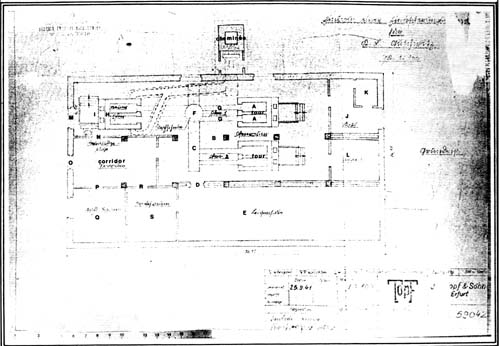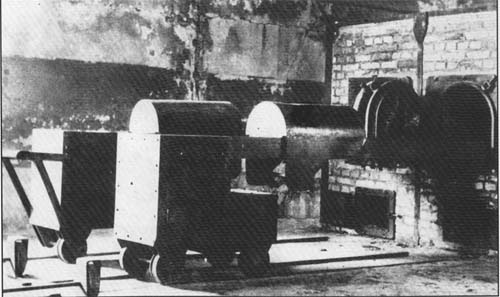| [Annex 18 to Volume XI of the Hoess trial] |
| DEPOSITION |
| In Auschwitz, on 24th May 1945, Jan Sehn, examining judge in Cracow, member of the Central Commission for the Investigation of Hitlerite Crimes in Poland, at the request of, in the presence of and with the participation of the vice-prosecutor of the Cracow Regional Court. Edward Pechalski, pursuant to Article 254 and in connection with Articles 107 and 115 of the Criminal Code, interrogated former Auschwitz concentration camp prisoner 90124, who testified as follows: |
My name is HENRYK TAUBER, I was born on 8th July 1917 in Chrzanow, son of Abraham Tauber and Minda née Seajnowic, unmarried, of the Jewish faith, of Polish nationality and citizenship, shoemaker by trade, domiciled at 1 Grunwaldzka Street, Chrzanow, with no police record.
|
Until the war broke out in 1939, I lived with my immediate family of 12 persons in Chrzanow. Of this family, one of my brothers-in-law and myself are the only ones to have survived the war. Up to now I have had no news of the fate of one of my brothers who went to Russia. After many expropriations and displacements, my family and I were separated and I found myself in the Cracow ghetto. There, I was arrested in November 1942 and incarcerated in the Jewish police prison at 31 Jozefinska Street. On 19th January 1943, I was transfered to Auschwitz with 400 Jews from the Cracow ghetto and 800 Aryans from Monteluppich [Cracow prison]. This transport consisted of about 800 men and 400 women. On our arrival at Auschwitz station, the women were separated from the men and installed in the women’s camp in Birkenau. Included in a group of 250 Jewish prisoners and about 550 Aryans, I was assigned to block 27, sector BIb. This block was unfinished, without windows,doors or bunks. Later on, I went to blocks 22 and 20 in the same sector of the camp. I spent a few days at Buna [Monowitz] from where, because of typhus detected in my group, I was transfered back to Birkenau and put in block 21 of sector BIb. In the meantime, there were the formalities of registration, during which I stated that 1 was a qualified fitter-mechanic by trade.
At the beginning of February 1943, Unterscharführer [sergeant] Groll of the Arbeitsdienst [labour service] and prisoner Mikusz of the Arbeitseinsatz [labour deployment] came to our block and selected from among the prisoners living there some specialists for what was was supposed to be work in the Auschwitz workshops. Twenty young Jews were picked out. We were then taken to block IV [main camp] where we were examined by a doctor who declared us all fit. The same day we were taken by truck, under SS guard, to Auschwitz and installed in Bunker 7 [basement cell] in block XI [main camp]. The next day we, the twenty prisoners, were taken under a stronger SS guard, to the bunker in which, as we learned later, Krematorium I was installed. There we met seven Jews, among them Jankowski and three Poles. The Capo was Mietek Morawa from Cracow. He was a tall, blond, slim man about 24 years old. One of his brothers was a boxer in Cracow. I heard that Morawa’s family lived in Debnikach [a district of Cracow]. From the very beginning of his activity in the first crematorium [Kr I], he was a very strict Capo who carried out the work ordered) by the Germans in conformity with the regulations. Later on, he was promoted to Obercapo [principal Capo] of Birkenau Krematorien II and III. There, he tried to live on good terms with us, for there were then about 400 of us and we had been working there long enough to be ready for anything and to let nobody spit in our plate [Polish expression: “not let anyone walk over us"].
The day after our arrival at the crematorium (Kr I] [Document 5], an SS Unterscharführer [sergeant] whose name I forget gave us a pep talk [this scene took place in the northwest yard of Krematorium I, which was at that time enclosed by a fence]. He warned us that we were going to have to do unpleasant work to which we would have to accustom ourselves, and which after a certain time would present no more difficulty. He spoke in Polish the whole time. Never during all his speech did he once mention the fact that we would have to burn the bodies of human beings. As soon as he finished the speech, he ordered “Los, an die Arbeit!” [OK, get to work] and started beating our heads with a bludgeon. With Mietek Morowa,he drove us towards the bunker [Leichenhalle, or morgue] of Krematorium I, where we discovered some hundreds of corpses. They were in heaps, one on top of the other, dirty and frozen. Many of them were covered in blood. their skulls crushed. others had their stomachs open, probably as the result of autopsy. All were frozen and we had to separate them from one another with axes. Beaten, and harrassed by the Unterscharführer and Capo Morawa, we dragged these corpses to the “hajcownia” (German-Polish term meaning “boiler room"], where there were three furnaces, each with two muffles [Document 6]. I designate as “muffle”, in conformity with the nomenclature used by the Soviet Commission, the corpse incineration hearths [A — see Document 5]. |
|
 |
Document 5 |
|
Document 5: Drawing of Krematorium I
[PMO neg, no. 20818/1] |
|
Drawing No D.59042 by J A Topf & Söhne of Erfurt, dated 25/9/41. “Einbau einer Einäscherungsanlage fur KL. Auschwitz / Installation of a cremation facility for Auschwitz Concentration Camp”.
[This drawing concerns the installation of the third furnace, “Neuer Ofen / new furnace”, fitted with a “Druckluftgebläse / pulsed air blower"] |
|
|
| Document 6 |
 |
|
| |
Document 6:
[Photo on page 65 of “KL AUSCHWITZ” published by the Auschwitz International Committee, undated] |
| |
Present state of the eastern corner of the Krematorium I furnace room. Two of the three corpse charging trolleys found after the liberation of the camp have been put back in place before the cremation muffles.They are incomplete: the one on the left lacks a wheel and the one in the foreground lacks the manoeuvring handle. This photograph enables anybody who has nor actually visited Auschwitz to form an opinion on the value of one testimony that claimed it was possible to introduce twelve corpses into a single muffle. This photo makes it clear that even the figure of five “musulmans” put forward by Henryk Tauber is at the limit of the possible. |
|

